商业银行风险管理-课后练习答案
- 格式:docx
- 大小:67.62 KB
- 文档页数:7
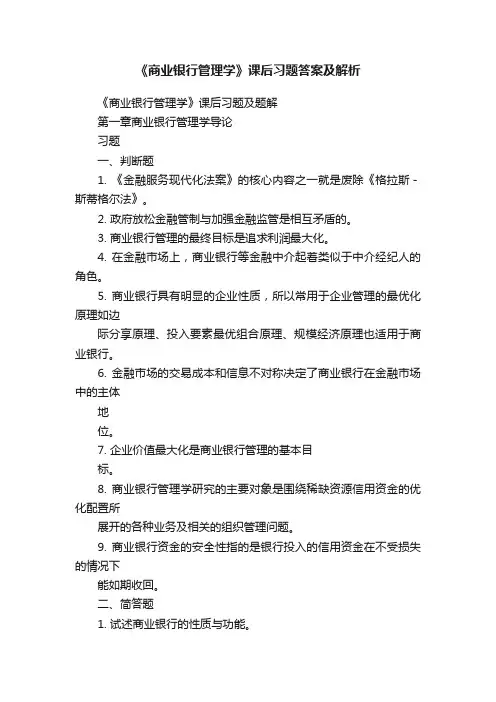
《商业银行管理学》课后习题答案及解析《商业银行管理学》课后习题及题解第一章商业银行管理学导论习题一、判断题1. 《金融服务现代化法案》的核心内容之一就是废除《格拉斯-斯蒂格尔法》。
2. 政府放松金融管制与加强金融监管是相互矛盾的。
3. 商业银行管理的最终目标是追求利润最大化。
4. 在金融市场上,商业银行等金融中介起着类似于中介经纪人的角色。
5. 商业银行具有明显的企业性质,所以常用于企业管理的最优化原理如边际分享原理、投入要素最优组合原理、规模经济原理也适用于商业银行。
6. 金融市场的交易成本和信息不对称决定了商业银行在金融市场中的主体地位。
7. 企业价值最大化是商业银行管理的基本目标。
8. 商业银行管理学研究的主要对象是围绕稀缺资源信用资金的优化配置所展开的各种业务及相关的组织管理问题。
9. 商业银行资金的安全性指的是银行投入的信用资金在不受损失的情况下能如期收回。
二、简答题1. 试述商业银行的性质与功能。
2. 如何理解商业银行管理的目标?3. 现代商业银行经营的特点有哪些?4. 商业银行管理学的研究对象和内容是什么?5. 如何看待“三性”平衡之间的关系?三、论述题1. 论述商业银行的三性目标是什么,如何处理三者之间的关系。
2. 试结合我国实际论述商业银行在金融体系中的作用。
第一章习题参考答案一、判断题1.√2.×3.×4.√5.×6.√7.×8.√9.√二、略;三、略。
第二章商业银行资本金管理习题一、判断题1. 新巴塞尔资本协议规定,商业银行的核心资本充足率仍为4%。
2. 巴塞尔协议规定,银行附属资本的合计金额不得超过其核心资本的50%。
3. 新巴塞尔资本协议对银行信用风险提供了两种方法:标准法和内部模型法。
4. 资本充足率反映了商业银行抵御风险的能力。
5. 我国国有商业银行目前只能通过财政增资的方式增加资本金。
6. 商业银行计算信用风险加权资产的标准法中的风险权重由监管机关规定。
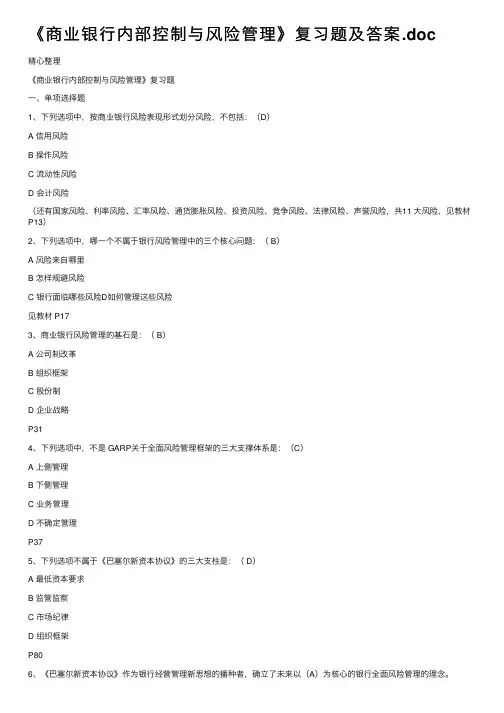
《商业银⾏内部控制与风险管理》复习题及答案.doc精⼼整理《商业银⾏内部控制与风险管理》复习题⼀、单项选择题1、下列选项中,按商业银⾏风险表现形式划分风险,不包括:(D)A 信⽤风险B 操作风险C 流动性风险D 会计风险(还有国家风险、利率风险、汇率风险、通货膨胀风险、投资风险、竞争风险、法律风险、声誉风险,共11 ⼤风险,见教材P13)2、下列选项中,哪⼀个不属于银⾏风险管理中的三个核⼼问题:( B)A 风险来⾃哪⾥B 怎样规避风险C 银⾏⾯临哪些风险D如何管理这些风险见教材 P173、商业银⾏风险管理的基⽯是:( B)A 公司制改⾰B 组织框架C 股份制D 企业战略P314、下列选项中,不是 GARP关于全⾯风险管理框架的三⼤⽀撑体系是:(C)A 上侧管理B 下侧管理C 业务管理D 不确定管理P375、下列选项不属于《巴塞尔新资本协议》的三⼤⽀柱是:( D)A 最低资本要求B 监管监察C 市场纪律D 组织框架P806、《巴塞尔新资本协议》作为银⾏经营管理新思想的播种者,确⽴了未来以(A)为核⼼的银⾏全⾯风险管理的理念。
C 市场纪律D 国家监管P877、风险管理的核⼼⼯具是:(C)AVAR法 B 外部评级系统 C 内部评级系统 D 德尔菲法见教材 P1038、在商业银⾏⾯临的各种风险中,被称为“⽴即死亡”的风险是指:( C)A 操作风险B 信⽤风险C 流动风险D 市场风险P1159、下列选项,不是常⽤的市场风险限额是:(B)A 交易限额B 缺⼝限额C 风险限额D ⽌损限额P13610、下列选项中不属于“货款三查”的是:(C)A 货前调查B 货时审查C 货中抽查D 货后检查P15711、下列选项中不属于操作风险管理⼀般框架中的风险战略是:(A)A 风险评估B 业务⽬标C 风险偏好D 风险政策P169-17012、下列选项中不属于操作风险管理中风险评估的⽅法是:(D)A 记分卡法B 检查表法( P173,还有⼯作间交流法,共 4 种⽅法)13、下列不是商业银⾏的三性是:(D)A 安全性B 稳定性C 流动性D 风险性⼆、填空题1、巴塞尔银⾏监管委员会规定银⾏的核⼼资本充⾜率不低于(4%),总体资本充⾜率不低于(8%)。

银行风险管理试题及答案分析-CAL-FENGHAI-(2020YEAR-YICAI)_JINGBIAN第1题下列选项中,不属于风险控制流程应当符合的要求的是() A.风险控制应与商业银行的整体战略目标保持一致B.能够发现风险管理中存在的问题,并重新完善风险管理程序C.所采取的具体控制措施与缓释工具符合成本/收益要求D.所采取的具体控制措施与缓释工具符合成本/利润要求正确答案:D解析:所采取的具体控制措施与缓释工具符合成本/收益要求,D项明显错误。
第2题资产证券化的作用在于() A.提高商业银行资产的流动性B.增强商业银行关于资产和负债管理的自主性C.是一种风险转移的风险管理方法D.以上都正确正确答案:D解析:资产证券化的主要目的在于变存量为流量,提高商业银行资产的流动性,增强商业银行关于资产和负债管理的自主性,也是一种分先转移的风险管理方法。
第3题以下负债中对商业银行的风险状况和利率水平敏感性最低,不容易对商业银行的流动性造成显着影响的是() A.社团存款 B.个人存款C.中小企业存款 D.集团公司存款正确答案:B解析:零售客户对商业银行的风险状况和利率水平缺乏敏感度,存款的意愿通常取决于自身的金融知识和经验、银行的地理位置、产品种类和服务质量的感性因素,因此零售存款相对稳定。
第4题对维持本行资本充足率承担最终责任的是() A.股东大会和董事会B.董事会和监事会C.董事会和高级管理层D.高级管理层和内部审计人员正确答案:C解析:董事会和高级管理层对维持本行资本充足率承担最终责任。
第5题以下哪项是银行监管的首要环节() A.机构准入 B.市场准入C.高级管理人员准入 D.运营准入正确答案:B解析:市场准入是银行监管的首要环节,把好市场准入关是保障银行机构稳健运行和金融体系安全的重要基础。
第6题对于操作风险,商业银行可以采取的风险加权资产计算方法不包括() A.标准法B.基本指标法C.内部模型法 D.高级计量法正确答案:C解析:对于操作风险,商业银行可以采用基本指标法、标准法或高级计量法。
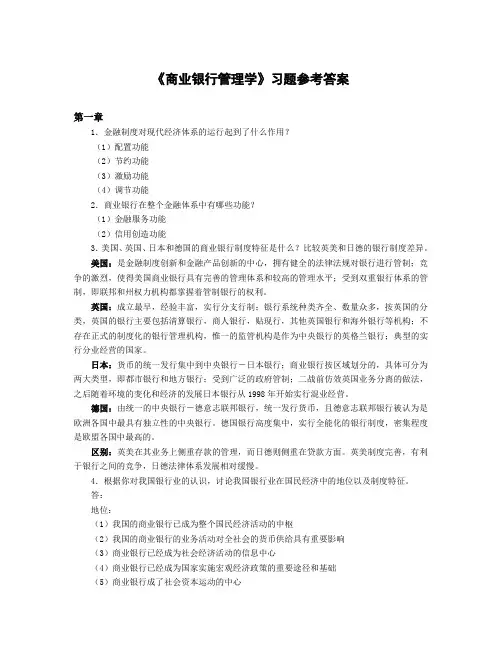
《商业银行管理学》习题参考答案第一章1.金融制度对现代经济体系的运行起到了什么作用?(1)配置功能(2)节约功能(3)激励功能(4)调节功能2.商业银行在整个金融体系中有哪些功能?(1)金融服务功能(2)信用创造功能3.美国、英国、日本和德国的商业银行制度特征是什么?比较英美和日德的银行制度差异。
美国:是金融制度创新和金融产品创新的中心,拥有健全的法律法规对银行进行管制;竞争的激烈,使得美国商业银行具有完善的管理体系和较高的管理水平;受到双重银行体系的管制,即联邦和州权力机构都掌握着管制银行的权利。
英国:成立最早,经验丰富,实行分支行制;银行系统种类齐全、数量众多,按英国的分类,英国的银行主要包括清算银行,商人银行,贴现行,其他英国银行和海外银行等机构;不存在正式的制度化的银行管理机构,惟一的监管机构是作为中央银行的英格兰银行;典型的实行分业经营的国家。
日本:货币的统一发行集中到中央银行-日本银行;商业银行按区域划分的,具体可分为两大类型,即都市银行和地方银行;受到广泛的政府管制;二战前仿效英国业务分离的做法,之后随着环境的变化和经济的发展日本银行从1998年开始实行混业经营。
德国:由统一的中央银行-德意志联邦银行,统一发行货币,且德意志联邦银行被认为是欧洲各国中最具有独立性的中央银行。
德国银行高度集中,实行全能化的银行制度,密集程度是欧盟各国中最高的。
区别:英美在其业务上侧重存款的管理,而日德则侧重在贷款方面。
英美制度完善,有利于银行之间的竞争,日德法律体系发展相对缓慢。
4.根据你对我国银行业的认识,讨论我国银行业在国民经济中的地位以及制度特征。
答:地位:(1)我国的商业银行已成为整个国民经济活动的中枢(2)我国的商业银行的业务活动对全社会的货币供给具有重要影响(3)商业银行已经成为社会经济活动的信息中心(4)商业银行已经成为国家实施宏观经济政策的重要途径和基础(5)商业银行成了社会资本运动的中心制度特征:建立商业银行原则,有利于银行竞争,有利于保护银行体系安全与稳定,使银行保持适当规模。
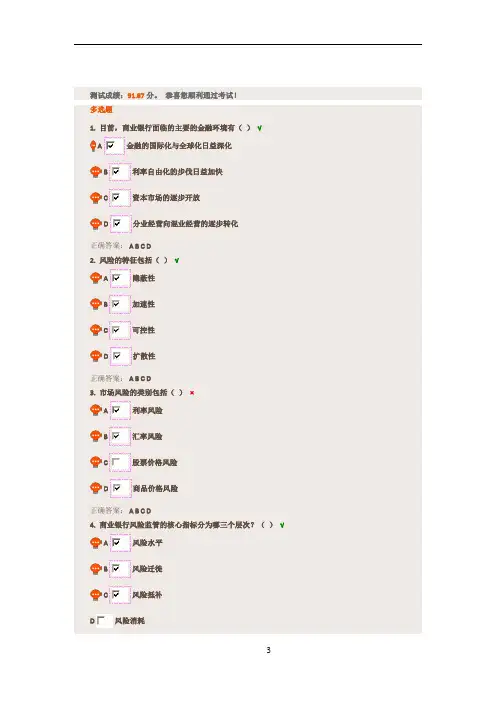
测试成绩:91.67分。
恭喜您顺利通过考试!多选题1. 目前,商业银行面临的主要的金融环境有()√A 金融的国际化与全球化日益深化B 利率自由化的步伐日益加快C 资本市场的逐步开放D 分业经营向混业经营的逐步转化正确答案: A B C D2. 风险的特征包括()√A 隐蔽性B 加速性C 可控性D 扩散性正确答案: A B C D3. 市场风险的类别包括()×A 利率风险B 汇率风险C 股票价格风险D 商品价格风险正确答案: A B C D4. 商业银行风险监管的核心指标分为哪三个层次?()√A 风险水平B 风险迁徙C 风险抵补D 风险消耗正确答案: A B C5. 商业银行的风险管理程序包括()√A 风险识别B 风险估价C 风险评价D 风险处理正确答案: A B C D6. 风险管理体系包括()√A 组织系统B 信息系统C 预警系统D 监控系统正确答案: A B C D7. 风险管理技术包括()√A 风险预防B 风险回避C 风险分散D 风险转移正确答案: A B C D8. 我国银行业的操作风险可以分为哪几类()√A 人员B 内部程序C 系统D 外部事件正确答案: A B C D9. 银行柜面操作风险的表现形式包括()√A 操作失误型B 主观违规型C 内部欺诈型D 外部欺诈型正确答案: A B C D10. 制定商业银行风险监管核心指标是为了加强对商业银行风险的()√A 识别B 评价C 预警D 控制正确答案: A B C判断题11. 巴塞尔委员会规定,银行资产负债的流动性比率不得低于25%。
√正确错误正确答案:正确12. 核心负债与负债总额之比,不应低于()√0.50.60.650.7正确答案: 0.6。
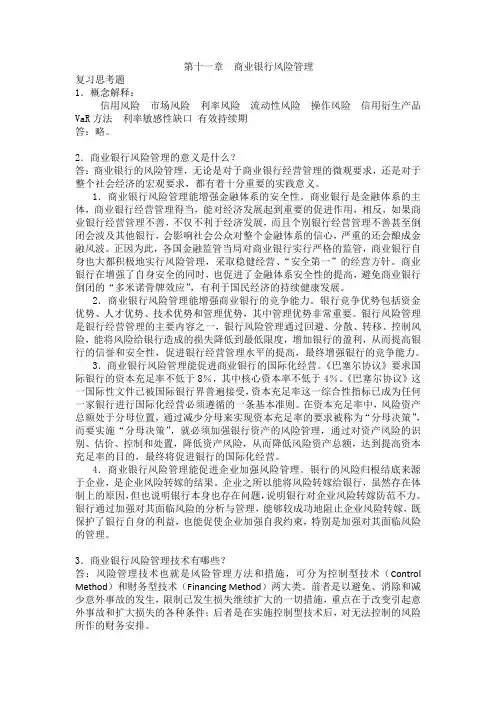
第十一章商业银行风险管理复习思考题1.概念解释:信用风险市场风险利率风险流动性风险操作风险信用衍生产品VaR方法利率敏感性缺口有效持续期答:略。
2.商业银行风险管理的意义是什么?答:商业银行的风险管理,无论是对于商业银行经营管理的微观要求,还是对于整个社会经济的宏观要求,都有着十分重要的实践意义。
1.商业银行风险管理能增强金融体系的安全性。
商业银行是金融体系的主体,商业银行经营管理得当,能对经济发展起到重要的促进作用,相反,如果商业银行经营管理不善,不仅不利于经济发展,而且个别银行经营管理不善甚至倒闭会波及其他银行,会影响社会公众对整个金融体系的信心,严重的还会酿成金融风波。
正因为此,各国金融监管当局对商业银行实行严格的监管,商业银行自身也大都积极地实行风险管理,采取稳健经营、“安全第一”的经营方针。
商业银行在增强了自身安全的同时,也促进了金融体系安全性的提高,避免商业银行倒闭的“多米诺骨牌效应”,有利于国民经济的持续健康发展。
2.商业银行风险管理能增强商业银行的竞争能力。
银行竞争优势包括资金优势、人才优势、技术优势和管理优势,其中管理优势非常重要。
银行风险管理是银行经营管理的主要内容之一,银行风险管理通过回避、分散、转移、控制风险,能将风险给银行造成的损失降低到最低限度,增加银行的盈利,从而提高银行的信誉和安全性,促进银行经营管理水平的提高,最终增强银行的竞争能力。
3.商业银行风险管理能促进商业银行的国际化经营。
《巴塞尔协议》要求国际银行的资本充足率不低于8%,其中核心资本率不低于4%。
《巴塞尔协议》这一国际性文件已被国际银行界普遍接受,资本充足率这一综合性指标已成为任何一家银行进行国际化经营必须遵循的一条基本准则。
在资本充足率中,风险资产总额处于分母位置,通过减少分母来实现资本充足率的要求被称为“分母决策”,而要实施“分母决策”,就必须加强银行资产的风险管理,通过对资产风险的识别、估价、控制和处置,降低资产风险,从而降低风险资产总额,达到提高资本充足率的目的,最终将促进银行的国际化经营。

一、二、单选1.商业银行有效的战略风险管理应当确保期长期战略、短期目标、( A)和可利用资源紧密联系在一起。
A.风险管理措施B.员工利益C.连续营业方案D.资本实力【解析】有效的战略风险管理流程应当确保商业银行的长期战略、短期目标、风险管理措施和可利用资源紧密联系在一起。
与声誉风险相似,战略风险产生于商业银行运营的所有层面和环节,并与市场风险、信用风险、操作风险和流动性风险等交织在一起。
2.商业银行的声誉危机管理应当建立在( B)的基础上,而且如果能够在监管部门采取行动之前妥善处理,将取得更好的效果。
A.良好的内部控制和机构利益B.良好的道德规范和公众利益C.良好的道德规范和股东利益D.维护股东利益【解析】传统上,危机管理主要采用“辩护或否认”的对抗战略推卸责任,但往往招致更强烈的对抗行动,如今更加具有建设性的危机处理方法是“化敌为友”,敢于面对暂时性的危机或挑战,勇于承担责任并与内外部利益持有者协商解决问题,以缓解利益持有者的持续对抗。
因此,声誉危机管理应当建立在良好的道德规范和公众利益基础上,而且如果能够在监管部门采取行动之前妥善处理,将取得更好的效果。
3将商业银行的(B)和经营目标结合起来,是创造公共透明度、维护商业银行声誉的一个重要层面。
A.盈利能力B.企业社会责任C.领导能力D.战略发展计划【解析】将商业银行的企业社会责任和经营目标结合起来,是创造公共透明度、维护商业银行声誉的一个重要层面。
商业银行应当不仅在其内部广泛传播价值理念,也应当将这种价值观延续到其合作伙伴、客户和供应商/服务商,并在整个经济和社会环境中,树立富有责任感并值得信赖的机构形象。
4.声誉风险通常与信用、市场、操作等风险( C)。
A.相互排斥、互不共存B.相互独立、互不影响C.交叉存在、互相作用 D.没有关系【解析】声誉风险可能产生于商业银行运营的任何环节,并通常与信用、市场、操作、流动性等风险交叉存在、相互作用。
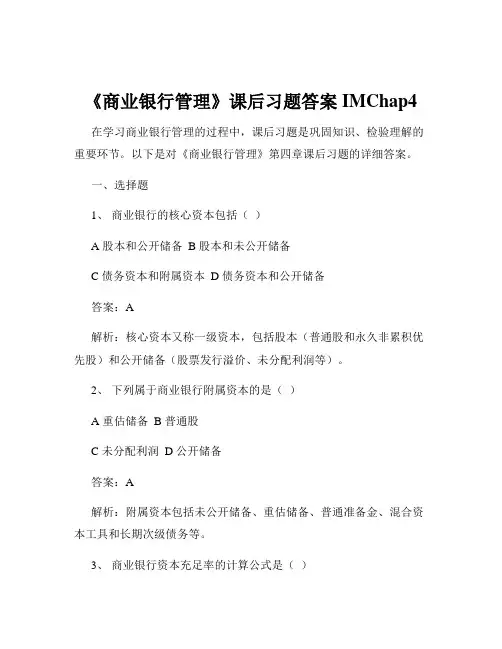
《商业银行管理》课后习题答案IMChap4在学习商业银行管理的过程中,课后习题是巩固知识、检验理解的重要环节。
以下是对《商业银行管理》第四章课后习题的详细答案。
一、选择题1、商业银行的核心资本包括()A 股本和公开储备B 股本和未公开储备C 债务资本和附属资本D 债务资本和公开储备答案:A解析:核心资本又称一级资本,包括股本(普通股和永久非累积优先股)和公开储备(股票发行溢价、未分配利润等)。
2、下列属于商业银行附属资本的是()A 重估储备B 普通股C 未分配利润D 公开储备答案:A解析:附属资本包括未公开储备、重估储备、普通准备金、混合资本工具和长期次级债务等。
3、商业银行资本充足率的计算公式是()A 资本/风险加权资产B 资本/总资产C (核心资本+附属资本)/风险加权资产D (核心资本+附属资本)/总资产答案:C解析:资本充足率=(核心资本+附属资本)/风险加权资产。
4、按照《巴塞尔协议》的要求,商业银行的资本充足率不得低于()A 4%B 8%C 10%D 12%答案:B解析:《巴塞尔协议》规定商业银行的资本充足率不得低于 8%。
二、简答题1、简述商业银行资本的作用。
答:商业银行资本具有以下重要作用:首先,资本为银行的开业、正常经营和持续增长提供了资金基础。
它是银行设立和注册的必要条件,为银行的初期运营提供启动资金。
其次,资本是银行抵御风险的重要防线。
在面临各种风险如信用风险、市场风险、操作风险等时,资本可以吸收损失,保护存款人和其他债权人的利益,维持银行的信誉和稳定。
再者,资本有助于树立公众对银行的信心。
充足的资本向外界传递了银行稳健经营、有能力应对潜在风险的信号,增强了客户、投资者和监管机构对银行的信任。
此外,资本还为银行的扩张和业务发展提供了支持。
银行可以利用资本进行新业务的开拓、分支机构的设立以及技术设备的更新等。
2、简述《巴塞尔协议》对商业银行资本构成的规定。
答:《巴塞尔协议》将商业银行的资本分为核心资本和附属资本两大部分。
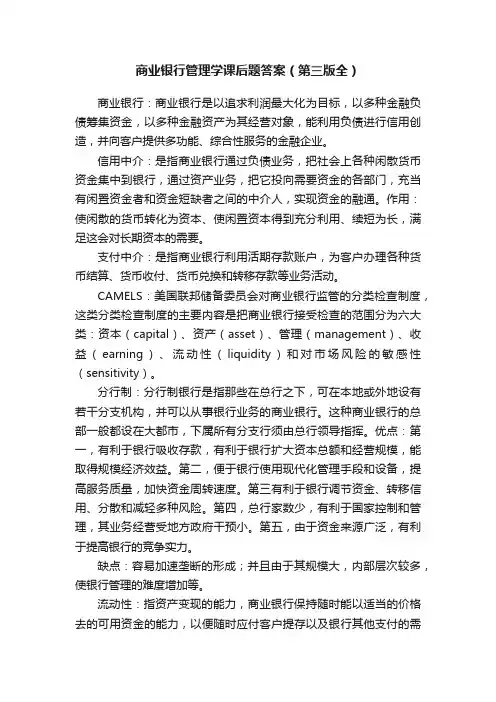
商业银行管理学课后题答案(第三版全)商业银行:商业银行是以追求利润最大化为目标,以多种金融负债筹集资金,以多种金融资产为其经营对象,能利用负债进行信用创造,并向客户提供多功能、综合性服务的金融企业。
信用中介:是指商业银行通过负债业务,把社会上各种闲散货币资金集中到银行,通过资产业务,把它投向需要资金的各部门,充当有闲置资金者和资金短缺者之间的中介人,实现资金的融通。
作用:使闲散的货币转化为资本、使闲置资本得到充分利用、续短为长,满足这会对长期资本的需要。
支付中介:是指商业银行利用活期存款账户,为客户办理各种货币结算、货币收付、货币兑换和转移存款等业务活动。
CAMELS:美国联邦储备委员会对商业银行监管的分类检查制度,这类分类检查制度的主要内容是把商业银行接受检查的范围分为六大类:资本(capital)、资产(asset)、管理(management)、收益(earning)、流动性(liquidity)和对市场风险的敏感性(sensitivity)。
分行制:分行制银行是指那些在总行之下,可在本地或外地设有若干分支机构,并可以从事银行业务的商业银行。
这种商业银行的总部一般都设在大都市,下属所有分支行须由总行领导指挥。
优点:第一,有利于银行吸收存款,有利于银行扩大资本总额和经营规模,能取得规模经济效益。
第二,便于银行使用现代化管理手段和设备,提高服务质量,加快资金周转速度。
第三有利于银行调节资金、转移信用、分散和减轻多种风险。
第四,总行家数少,有利于国家控制和管理,其业务经营受地方政府干预小。
第五,由于资金来源广泛,有利于提高银行的竞争实力。
缺点:容易加速垄断的形成;并且由于其规模大,内部层次较多,使银行管理的难度增加等。
流动性:指资产变现的能力,商业银行保持随时能以适当的价格去的可用资金的能力,以便随时应付客户提存以及银行其他支付的需要。
其衡量指标有两个:一是资产变现的成本,二是资产变现的速度。
4.建立商业银行制度的基本原则有哪些?为什么要确立这些原则?答:(一)有利于银行业竞争。
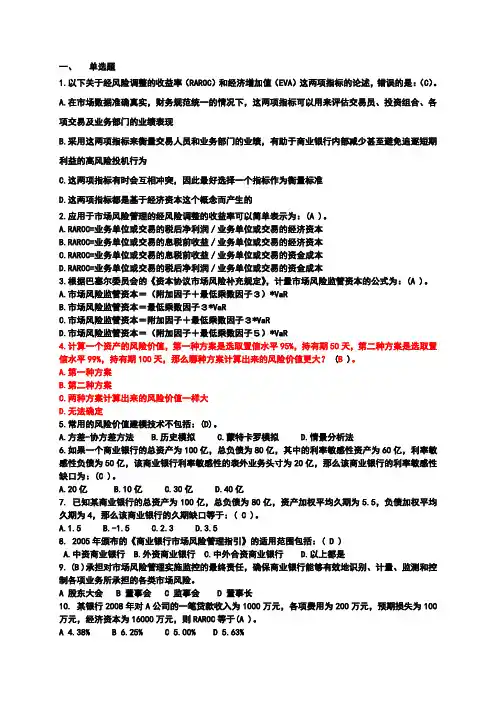
一、单选题1.以下关于经风险调整的收益率(RAROC)和经济增加值(EVA)这两项指标的论述,错误的是:(C)。
A.在市场数据准确真实,财务规范统一的情况下,这两项指标可以用来评估交易员、投资组合、各项交易及业务部门的业绩表现B.采用这两项指标来衡量交易人员和业务部门的业绩,有助于商业银行内部减少甚至避免追逐短期利益的高风险投机行为C.这两项指标有时会互相冲突,因此最好选择一个指标作为衡量标准D.这两项指标都是基于经济资本这个概念而产生的2.应用于市场风险管理的经风险调整的收益率可以简单表示为:(A )。
A.RAROC=业务单位或交易的税后净利润/业务单位或交易的经济资本B.RAROC=业务单位或交易的息税前收益/业务单位或交易的经济资本C.RAROC=业务单位或交易的息税前收益/业务单位或交易的资金成本D.RAROC=业务单位或交易的税后净利润/业务单位或交易的资金成本3.根据巴塞尔委员会的《资本协议市场风险补充规定》,计量市场风险监管资本的公式为:(A )。
A.市场风险监管资本=(附加因子+最低乘数因子3)*VaRB.市场风险监管资本=最低乘数因子3*VaRC.市场风险监管资本=附加因子+最低乘数因子3*VaRD.市场风险监管资本=(附加因子+最低乘数因子5)*VaR4.计算一个资产的风险价值,第一种方案是选取置信水平95%,持有期50天,第二种方案是选取置信水平99%,持有期100天,那么哪种方案计算出来的风险价值更大? (B )。
A.第一种方案B.第二种方案C.两种方案计算出来的风险价值一样大D.无法确定5.常用的风险价值建模技术不包括:(D)。
A.方差-协方差方法B.历史模拟C.蒙特卡罗模拟D.情景分析法6.如果一个商业银行的总资产为100亿,总负债为80亿,其中的利率敏感性资产为60亿,利率敏感性负债为50亿,该商业银行利率敏感性的表外业务头寸为20亿,那么该商业银行的利率敏感性缺口为:(C )。

测试成绩:91.67分。
恭喜您顺利通过考试!多选题1. 目前,商业银行面临的主要的金融环境有()√A 金融的国际化与全球化日益深化B 利率自由化的步伐日益加快C 资本市场的逐步开放D 分业经营向混业经营的逐步转化正确答案: A B C D2. 风险的特征包括()√A 隐蔽性B 加速性C 可控性D 扩散性正确答案: A B C D3. 市场风险的类别包括()×A 利率风险B 汇率风险C 股票价格风险D 商品价格风险正确答案: A B C D4. 商业银行风险监管的核心指标分为哪三个层次?()√A 风险水平B 风险迁徙C 风险抵补D 风险消耗5. 商业银行的风险管理程序包括()√A 风险识别B 风险估价C 风险评价D 风险处理正确答案: A B C D6. 风险管理体系包括()√A 组织系统B 信息系统C 预警系统D 监控系统正确答案: A B C D7. 风险管理技术包括()√A 风险预防B 风险回避C 风险分散D 风险转移正确答案: A B C D8. 我国银行业的操作风险可以分为哪几类()√A 人员B 内部程序C 系统D 外部事件9. 银行柜面操作风险的表现形式包括()√A 操作失误型B 主观违规型C 内部欺诈型D 外部欺诈型正确答案: A B C D10. 制定商业银行风险监管核心指标是为了加强对商业银行风险的()√A 识别B 评价C 预警D 控制正确答案: A B C判断题11. 巴塞尔委员会规定,银行资产负债的流动性比率不得低于25%。
√正确错误正确答案:正确12. 核心负债与负债总额之比,不应低于()√0.50.60.650.7正确答案: 0.6。
CHAPTER 21PRICING CONSUMER AND REAL ESTATE LOANSGoal of the Chapter: To learn how consumer and real estate loan rates may be determined and to see the options a bank loan officer has today in pricing loans to individuals and families.Key Terms Presented in This ChapterAnnual percentage rate (APR) Compensating deposit balanceSimple interest Fixed rate mortgages (FRMs)Discount rate method Adjustable-rate mortgages (ARMs)Add-on method PointsRule of 78sChapter OutlineI. Introduction: The Challenge of Pricing Consumer and Real Estate LoansII. The Interest Rate Attached to Nonresidential Consumer LoansA. Cost-Plus Loan Rate ModelB. Annual Percentage RateC. Simple InterestD. The Discount Rate MethodE. The Add-On Loan Rate MethodF. Rule of 78sG. Compensating Balance RequirementsIII. Use of Variable Rates on Consumer LoansIV.Interest Rates on Home Mortgage LoansA.Fixed Rated MortgagesB.Variable Rate MortgagesC.Charging the Customer Mortgage PointsV Summary of the ChapterConcept Checks21-1. What options does a bank loan officer have in pricing consumer loansMost consumer loans, like most business loans, are priced off some base or cost rate, with a profit margin and compensation for risk added on. The rate on a consumer loan may be figured from the cost-plus model or the base-rate model. Most installment and lump-sum payment loans are made with fixed interest rates. However, due to the volatility of interest rates in the 1 970’s and 1980's, a greater number of floating rate consumer loans have appeared.21-2. Suppose a customer is offered a loan at a discount rate of 8 percent and pays $75 in interest at the beginning of the term of the loan. What net amount of credit did this customer receive?The relevant formula is:Then the net amount of credit received must be $75/.08 or $937.50.Suppose you are told that the effective rate on this loan is 12 percent. What is the average loan amount the customer had available during the year?In this instance:Interest Owed $75Effective loan ratio = Average Loan Amount During the Year= x = 0.12Then the average loan amount during the year must be:x = $75 = $625.0.1221-3. See if you can determine what APR you are charging a consumer loan customer using the tables inside the back cover of this text if you grant the customer a loan for 5 (payable in monthly installments) years which carries a finance charge per $100 of $42.74.The terms quoted mean that the customer must pay an APR of 15 percent according to the Annual Percentage Rate Table in the tables inside the text's back cover.21-4. A customer is quoted an APR of 16 percent on a loan of $10,000, lasting for 4 and payable in monthly installments years.According to the Table in Appendix B the Finance charge per $100 of amount financed must be $36.03 or $36.03 *100 = $3603 in total finance charges.Problems21-1. William Crenshaw, who owns a small retail business, has requested a personal loan of $4500 for one year. He asks for a lump-sum loan with no installment payments; the loan, as requested, will be repaid at the end of the year plus interest. However, the bank wants monthly payments at an annual interest rate of 13 percent.If Crenshaw had received the loan under his preferred terms he would pay:Discount Interest Owed $75 loan rate = Net Amount = x = 0.08 of Credit ReceivedInterest Owed = Principal *Rate * Time = $4500 * 0.13 * 1 = $585.On the other hand, if the loan is repaid in 12 equal monthly installments (of $375 apiece) theinterest owed would be:First Month: $4500 x 0.13 x 1/12 = $48.75Second Month: $4125 x 0.13 x 1/12 = $44.69Third Month: $3750 x 0.13 x 1/12 = $40.62Fourth Month: $3375 x 0.13 x 1/12 = $36.56Fifth Month: $3000 x 0.13 x 1/12 = $32.50Sixth Month: $2625 x 0.13 x 1/12 = $28.44Seventh Month: $2250 x 0.13 x 1/12 =$24.37Eighth Month: $1875 x 0.13 x 1/12 = $20.31Ninth Month: $1500 x 0.13 x 1/12 = $16.25Tenth Month: $1125 x O.13 x 1/12 = $12.19Eleventh Month: $750 x 0.13 x 1/12 = $ 8.12Twelfth Month: $375 x 0.13 x 1/12 = $ 4.06Total Interest Paid $316.86In straight dollar terms it appears that Crenshaw pays less interest ($316.86 versus $585) with the loan paid back in monthly installments rather than repayment of a lump sum at the end. However, because Crenshaw has use of only about half the loan's balance (or $2250) on average over the year when repayment is in 12 equal installments he pays an approximate effective interest rate of $316.86/$2250 or 14.08% with the installment loan which significantly exceeds the loan contract rate of 13% under the lump-sum loan contract. (Note: We emphasize the word approximate.)As an alternative solution to this problem, we could prepare an amortization schedule for this loan, which would look like the following:For a $4,500 loan with a 13% annual interest rate and repayment on a monthly basis, the payment each month would be $401.85.Interest PrincipalBeginning Balance Payment Portion Portion Ending Balance$4,500.00 $401.85 $48.75 $351.10 $4,148.90$4,148.90 $401.85 $44.95 $356.90 $3,792.00$3,792.00 $401.85 $41.08 $360.77 $3,431.23$3,431.23 $401.85 $37.17 $364.68 $3,066.55$3,066.55 $401.85 $33.22 $368.63 $2,697.92$2,697.92 $401.85 $29.23 $372.62 $2,523.30$2,523.30 $401.85 $25.19 $376.66 $2,146.64$2,146.64 $401.85 $23.26 $378.59 $1,768.05$1,768.05 $401.85 $19.15 $382.70 $1,385.35$1,385.35 $401.85 $15.01 $386.84 $ 998.51$ 998.51 $401.85 $10.82 $391.03 $ 607.48$ 607.48 $401.85 $ 6.58 $395.27 $ 212.21$ 212.21 $214.51* $ 2.30 $212.21 $ 0.00Total Interest Paid $336.71* The final payment will equal the balance remaining before the last payment plus the interest on that balance. In most, if not all cases, this payment will be different from the regular payment.21-2. Frank Petrel plans to start an auto repair shop and has requested a $10,000 new-venture loan. The bank wishes to make a discount-rate loan at prime plus 2 percentage points or 14.5 percent.This means Petrel will receive net loan proceeds of $10,000 - $10,000 * 0.145 = $8550.Using this net figure as a base, Petrel will pay an effective interest rate of$1450 / $8550 or 16.96%.Alternative Scenario 1:Would Mr. Petrel be better off if he were able to get a $10,000 personal loan with a 12.5% add-on rate for one year? Why or why not?Solution:In this instance, Petrel would have to repay the $10,000 plus $10,000 x 0.125 in interest or $1250. He would be asked to make monthly installment payments of ($10,000 + $1250) / 12or $937.50 per month for 12 months. Because Petrel would have only $5,000 in borrowed funds on average to use over a 12-month period, the approximate effective interest rate he would pay under the add-on rate method would be $1250 / $5000 or about 25 percent. (A financial calculator solution gives us an effective rate of 22.32%.) Clearly this effective rate would be much higher than the interest rate on the discount business loan.Alternative Scenario 2:What happens to the effective rate on Mr. Petrel's loan if the prime rate changes to 10 percent?Solution:The rate on Mr. Petrel's discounted loan would be 12 percent (10% + 2%).The net proceeds from the loan would, therefore, be$10,000 - ($10,000 * .12) = $10,000 - $1,200 = $8,800.The effective cost of the loan would then be$1,200 / $8,800 = .1364 or 13.64%. (Declines from 16.96%)Alternative Scenario 3:How does the effective rate on this loan change if the prime rate increases to 13 percent?Solution:The rate on Mr. Petrel's discounted loan would be 15 percent (13% + 2%).The net proceeds from the loan would be$10,000 - ($10,000 *.15) = $10,000 - $1,500 = $8,500.The effective cost of the loan would then be$1,500 / $8,500 = .1765 or 17.65%. (Increases from 16.96%)Alternative Scenario 4:Suppose Mr. Petrel is able to raise personal equity to put into the new business in the amount of $2,500 from his accumulated savings and from a small loan extended by a close friend. The bank will then lend him just $7,500 at a discount rate of prime plus one-and-one-half percentage points (currently prime is 12 percent). What is the effective interest rate on the loan in this case?Solution:The rate on Mr. Petrel's discounted loan would be 13.5 percent (12% + 1.5%).The net proceeds from the loan would be$7,500 - ($7,500 *.135) = $7,500- $1,012.50 = $6,487.50.The effective cost of the loan would then be$1,012.50 / $6,487.50 = .1561 or 15.61%.21-3. The Robbins family has asked for a 20-year mortgage in the amount of $60,000 to purchase a home. At a 10 percent loan rate, what is the required monthly payment?Solution:$579.01 1- 0.10/12) 1(0.10/12) (1 * 0.10/12 * 60,000$12*2012*20=++Because of the computational problems in the above formula, an easier approach is to use the tables inside the text's back cover to find the:Total Finance Charge Per $100 Financed = $131.61Total Finance Charge on the Loan Amount Requested =($60,000 / $100) x $131.61 = $78,966Required Monthly Payment = Total Finance Charge + Loan AmountNumber of Payments= [$78,966 + $60,000] / 240 = $ 579.03Alternative Scenario 1:If the Robbinses' home mortgage loan rate is adjustable and rises to 11 percent at the beginning of the second year of the loan, what will the required monthly payment be?Solution:$628.48 1- 0.11/12) 1(0.11/12) (1 * 0.11/12 * 000,60$12*1912*19=++Note that we assume the first-year loan rate is 10 percent and then rises to 11 percent for theremaining 19 years (or 228 months) of the 20 year loan. Also, for ease of calculations, we assume that there has been no significant reduction in the principal amount of the loan. In reality, the Robbins will have reduced the principal to approximately $59,000 at the end of the first year. Interpolation in the tables inside the text's back cover for an 11percent loan for 228 remaining monthly payments gives:Total Finance Usage Per $100 Financed = $104.59) - ($147.73 * 180- 240180-228 104.59$+= $104.59 + $34.51 = $139.10Total Finance Charge on Remainder of Loan = ($60,000/$100) * $139.10 = $83,460Required Monthly Payment = $59,000)on ($618 $629.21 228$60,000 $83,460=+Alternative Scenario 2:Suppose the rate on the Robbinses' home mortgage declines to 9 percent at the beginning of the loan's second year. What happens to the required monthly payment?Solution:Note: Since Table 3 in the Appendix does not have 9 percent, we will calculate the required monthly payment using a financial calculator.Required Monthly Payment for $60,000 at 9 percent (.75% per month) for 19 years/(228 months)= $550.14 ($540.97 for $59,000)Alternative Scenario 3:Would the Robbins family be better off under all of the above scenarios if they took out a 15-year mortgage instead of a 20-year mortgage? What would they gain and what would they give up with this mortgage loan of a shorter maturity?Solution:The answer to this question depends upon the Robbinses' ability to make the higher payments that would be required on a shorter term mortgage.In each case, the Robbinses would have a higher monthly payment; however, their total payments would be less, their home would be paid for in less time, and they would accumulate equity in the home more quickly.21-4. James Alters received a $1500 loan last month with the intention of repaying the loan in 12 months. However, Alters now discovers he has the cash to repay the loan right now after making just one payment. What percentage of the total finance charge is Alters entitled toreceive as a rebate and what percentage of the loan's finance charge is the bank entitled to keep?The Rule of 78s applies here. James Alters is entitled to receive back as an interest rebate:percent 63.33 = 100x 78671211...2111 + . . . + 2 + 1=++++of the total finance charges on the loan: the lender is entitled to keep 36.67 percent of the finance charges associated with this loan.21-5. Constance Homer asks for a $10,000 loan. Slidell Corners State Bank agrees to give her immediate use of $9400 and to deduct $600 in interest up front. The effective discount rate on this loan is:6.38% $9400$600 Received Credit of Amount Net Owed Interest ==21-6. The Lindal family wants to borrow $2500 for a year to finance a European vacation. If the family must pay a 12 percent add-on loan rate, how much in interest will they pay?Interest Paid = Loan principal * Loan Rate = $2500 * 0.12 = $300What is the amount of each required monthly payment?Amount of Monthly Payment = $233.33 12$300 $2500=+What is the effective loan rate in this case?Effective Loan Rate = 24%or 0.24 $1250$300 Year the During Amount Average Owed Interest ==21-7. The APR for Joseph Nework's $10,000, 3-year automobile loan can be determined from the annual percentage rate table for monthly payment plans inside the back cover of the text.If Joseph must pay $2217 in total finance charges over 36 months, the table tells us he is paying100$2217$ or $22.17 per $100 or an APR of 13.50 percent.21-8. If Kyle Ellisor is to receive a 30-year mortgage loan in the amount of $225,000 at an APR of 14%, he will pay finance charges of $326.55 per $100 borrowed over the life of this loan (see the annual percentage rate tables inside the back cover of the text). Therefore, he will pay in total finance charges$100$225,00* $326.55 = $734,737.50.21-9. The Quisling family asks to borrow $1800 at 11 percent simple interest for one year. It will pay the following interest bill:I = P * r * t = $1800 * 0.11 * l = $198Therefore, they must pay back a total of $1998 in principal and interest.21-10. Mary Perland will pay the following in interest on her $1200 loan for one year at 8 percent simple interest:First Quarter: I = $1200 x 0.08 x 1/4 = $24Second Quarter: I = $900 x 0.08 x 1/4 = $18Third Quarter: I = $600 x 0.08 x 1/4 = $12Fourth Quarter: I = $300 x 0.08 x 1/4 = $6Total Interest owed = $24 + $18 + $12 + $6 = $60.If Mary were offered the $1200 loan at a 6 percent simple interest rate and the loan is paid in lump sum at maturity, she will pay total interest of:$1200 * 0.06 x 1 = $72.She clearly would pay more in interest but would have the full $1200 available for her use for one year.21-11. The Tielman family has asked for a $2500 loan for one year to complete home repairs. First National Bank assesses an 8 percent rate of interest and requires a $500 minimum compensating balance left in a deposit. The effective interest rate on this loan must be:10%or 0.10 $2000$200 $500 - $25000.08 * $2500 Amount Loan Net Owed Interest ===Actually 10 percent is the minimum loan rate. If the Tielman's keep a deposit balance larger than the minimum $500 required the effective loan rate will climb higher.21-12. Bill and Sue Rogers are negotiating with their local bank for a home mortgage loan in the amount of $80,000. The bank levies an up-front fee of 1.5 points on this loan. The dollar amount of points they must pay upfront is:Dollar Value of Points = $80,000 * 0.015 = $1200.The Rogers will have available for their use only $78,800 or $80,000 less $1200.21-13 As a loan officer you quote Mr. and Mrs. Coldner an APR of 14 percent on a two year loan to remodel their kitchen. The loan amount is $6000. Using the APR tables inside the back cover of the text determine the total finance charge on this loan.$913.80 15.23 x $100$6000= is the total amount in finance charges the Coldner’s wi ll pay.If they insist on a 12 percent loan$778.80 12.98 x $100$6000= is the total amount in finance charges the Coldner’s will payThe bank will lose $13521-14. Dresden bank’s personal loan department quotes Mr. Angelo a finance charge of $6.06 for each $100 in credit the bank is willing to extend to him for a year (assuming the balance of the loan will be paid off in 12 equal installments). What APR is Mr. Angelo being quoted by the bank? How much would he save per $100 borrowed if he could retire the loan in 6 months?The APR on this loan is 11 percent. If he could retire the loan in 6 months the finance charges per $100 would be $3.23. He would save $2.83 per $100 borrowed.21-15. Would you expect loan interest rates on new cars to be higher than on used cars? Why or why not? Would you expect a personal loan to carry a higher interest rate than an automobile loan? Why or why not?I would expect the interest rate on the new car loan to less than the interest rate on a used car loan. In general, newer cars are easier to sell than used cars and the bank would stand a better chance of getting their money back in the event of default on the loan. However, this may depend on the make and model of the car and the market for used cars.I would expect the interest rate on the personal loan to be higher than the interest rate on the automobile loan. In the personal loan there may not be any specific and identifiable assets pledged as collateral on the loan. In the case of the automobile loan the car purchased is generally used as collateral. In the event of default it may be more difficult for the bank to get their funds back on the personal loan.Web Site Problems1. What methods are in greatest demand today to aid in the pricing of consumer loans and real estate (particularly housing) credit? How can the world wide web be of help in this area? What web sites look especially good?I believe that the most common method for calculating consumer loan interest rates and payments is the APR. Since this is the method that banks must report by law, it is now the most often used method for calculating payments on consumer loans. The web can help because there are a number of places on the web where can find information about prevailing interest rates on consumer loans and a number of places that will calculate your payments based on a particular APR and amount borrowed. For examplehttp://moneysense.quicken.ca/eng/auto/calculators/payments/index.phtml is a place to calculate automobile loans. There are many other places on the web where you can make the same calculation.2. Why is credit scoring useful in helping to price consumer and home mortgage loans? Where can you go to get good credit-scoring information?The demand for consumer loans has expanded exponentially in recent years. As a result the need for a quick and reliable way to determine whether an individual will pay back a loan was needed. This led to the development of credit scoring. There are many web sites that discuss credit scoring and the advantages and disadvantages of these models. One web site that I found is/article1.htm. This web site is good because it does give a history of why credit scoring models have developed and a very basic description of how it works and the advantages and disadvantages. In addition there are several web sites where you can get an estimate of your credit score.3. Why is regulation so important in the personal loan area? How can you use the web to stay abreast of rule changes in the consumer loan field?Regulations are needed in this important field because it is very easy to take advantage ofill-informed individuals by charging them excessive interest rates and fees. Because of the changing technology and increased consumer demand for loans there have been a number of changes in regulations for consumer lending in recent years and changes will continue to be made in the future. There are a number of sites out on the web to help individuals keep up with these changes. One place to check is with the regulatory agencies overseeing banks (OCC, FDIC, FRS) as these agencies regularly post updates to the laws. In addition, as a banker there are several web sites that advertise seminars and classes on consumer lending which would include a discussion of the latest laws and regulations in this important area. One web site that lists several classes in this area is the web site of the American Bankers Association (ABA) at/Conferences+and+Education/onlinecourse8.htm.。
*第一章风险管理基础测试成绩:60.0分。
恭喜您顺利通过考试!1、商业银行发行的理财产品出现与国内客户诉讼纠纷的负面事件,并在网络传 播,则商业银行面临的风险类型有()。
(3.33 分)正确答案:C2、商业银行通过银团贷款的方式来降低风险的做法属于()管理策略。
(3.33 分)1. 课程学习2. 课程评估3. 课后测试课后测试 声誉风险、 战略风险国别风险、 战略风险声誉风险、 法律风险国别风险、 法律风险风险转移风险分散风险对冲风险补偿正确答案:B3、商业银行所面临的违约风险、结算风险属于()类别。
( 3.33 分)市场风险流动性风险操作风险信用风险正确答案:D4、()属于商业银行所面临的市场风险。
(3.33 分)商业银行无力为负债的减少或资产的增加提供融资而造成损失或破产的风险金融资产价格和商品价格的波动给商业银行表内、表外头寸造成损失的风险交易双方在结算过程中,一方支付了合同资金但另一方发生违约的风险由于人为错误、流程缺失给商业银行造成损失的风险正确答案:B5、商业银行发放贷款时,未严格执行先落实抵押手续、后放款的规定,致使贷款处于无抵押的高风险状态,此类风险事件属于()类别。
( 3.33 分)操作风险流动性风险法律风险市场风险正确答案:A6下列不属于商业银行代理业务中的操作风险的是()。
( 3.33 分)代客理财产品由于市场利率波动而造成损失客户通过代理收付款进行洗钱活动委托方伪造收付款凭证骗取资金业务中贪污或截留代理业务手续费正确答案:A7、()是指由于不完善或有问题的内部程序、员工和信息科技系统,以及外部事件给银行造成损失的风险。
(__333__分)操作风险国家风险流动性风险市场风险正确答案:A8、下列关于风险的定义中,印证了商业银行力图通过改善公司治理结构、强化内部控制机制,从而降低风险损失的管理理念的是()。
( 3.33分)风险是未来结果的不确定性风险是未来的期望收益风险是未来的盈利风险是损失的可能性正确答案:A9、在商业银行的经营过程中,决定其风险承担能力的最重要因素是()。
经典资料,WORD文档,可编辑修改
经典考试资料,答案附后,看后必过,WORD文档,可修改
2013银行从业考试风险管理习题及答案
一、单选题共 42 题
题号: 1
巴塞尔委员会根据英国银行家协会、国际掉期和衍生品交易协会、风险管理协会及普华永道咨询公司的意见,将操作风险定义为
A、操作过程中产生的不确定性,并且人们不能精确预测这种不确定性的分布
B、由不完善或有问题的内部程序、人员及系统或外部事件所造成损失的风险
C、商业银行从业人员在交易或为客户提供其他服务时,面对的意外情况
D、由于市场竞争等原因,银行业务量变动所带来的风险
标准答案:B
题号: 2
核心雇员流失引发的风险属于人员因素引起的操作风险,它体现为对关键人员依赖的风险,下列哪一项不是这种风险的表现
A、缺乏足够的后援/替代人员
B、相关信息缺乏共享和文档记录。
商业银行风险管理答案(5篇)第一篇:商业银行风险管理答案•1、银行业面临的最主要的风险是()(8.33 分)✔ A 市场风险✔ B 信用风险✔ C 操作风险✔ D 战略风险正确答案:B 多选题•1、风险的特征包括()(8.33 分)A 隐蔽性B 加速性C 可控性D 扩散性正确答案:A B C D •2、市场风险的类别包括()(8.33 分)A 利率风险B 汇率风险C 股票价格风险D 商品价格风险正确答案:A B C D •3、商业银行风险监管的核心指标分为哪三个层次?()(8.33 分)A 风险水平B 风险迁徙C 风险抵补D 风险消耗正确答案:A B C •4、风险管理体系包括()(8.33 分)A 组织系统B 信息系统C 预警系统D 监控系统正确答案:A B C D •5、我国银行业的操作风险可以分为哪几类()(A 人员B8.33 分)内部程序C 系统D 外部事件正确答案:A B C D •6、柜面操作风险的特征包括()(8.33 分)A 内生性B 多样性C 可控性D 损失的不确定性正确答案:A B D •7、银行柜面操作风险的表现形式包括()(8.33 分)A 操作失误型B 主观违规型C 内部欺诈型D 外部欺诈型正确答案:A B C D •8、制定商业银行风险监管核心指标是为了加强对商业银行风险的()(A8.33 分)识别B 评价C 预警D 控制正确答案:A B C 判断题•1、巴塞尔委员会规定,银行资产负债的流动性比率不得低于25%。
(8.33 分)✔ A 正确✔ B 错误正确答案:正确•2、累计外汇敞口头寸比例为累计外汇敞口头寸与资本净额之比,不应高于15%。
(8.33 分)✔ A 正确✔ B 错误正确答案:错误•3、核心负债与负债总额之比,不应低于()(8.37分)✔ A 0.5 ✔ B 0.6 ✔ C 0.65 ✔ D 0.7 正确答案:0.6第二篇:浅析商业银行风险管理浅析商业银行风险管理班级:13经济学六班姓名:钟子龙学号:20*** 【摘要】商业银行的性质决定了商业银行是一个不同于其他工商业的特殊企业,其突出特点是高风险性。
第1 题三项资产,头寸分别为2000 万元,3000 万元,5000 万元,年投资收益率分别为20%,10%,16%,那末由这三项资产组成的资产组合的年收益率为: ( )A .16%B .15%C .10%D .20%【正确答案】:B第 2 题商业银行在短期内的借入资金需求等于什么?( )A.借入资金=融资缺口+流动性资产B.借入资金=融资缺口+流动性负债C.借入资金=融资缺口+贷款平均额D.借入资金=融资缺口+核心存款平均额【正确答案】:A第3 题已知某商业银行的总资产为100 亿,总负债为80 亿,资产加权平均久期为5.5,负债加权平均久期为4,那末该商业银行的久期缺口等于: ( )A .1.5B .- 1.5C .2.3D .3.5【正确答案】:C第4 题《巴塞尔辛资本协议》鼓励商业银行采取什么方法计量信用风险?( )A.基于内部评级体系的内部模型B.基于外部评级的模型C .VaR 方法D.以上都不是【正确答案】:A第5 题现金流量表的组成部份不包括: ( )A.经营活动现金流B.投资活动现金流C.融资活动现金流D.意外现金流【正确答案】:D第6 题以下属于信用风险,又属于操作风险的是: ( )A.内部欺诈B.外部欺诈C.经营中断和系统瘫痪D.股市暴跌【正确答案】:B第7 题CreditMetrics 模型从本质上讲是: ( )A.是一个简单信用评分模型B.是一个VaR 模型C.是一个期权定价模型D.以上都不是【正确答案】:B第8 题利用死亡率模型计算违约概率,其数据来源是基于: ( ) A.历史违约数据B.预测数据C.蒙特卡罗摹拟D.情景分析【正确答案】:A第9 题以下关于历史摹拟法的缺陷的论述,不正确的是: ( )。
A.单纯依靠历史数据进行风险度量,将低估突发性收益率的波动B.风险度量的结果受制于历史周期的长度C.以大量历史数据为基础,对数据依赖性强D.存在相当程度的模型风险【正确答案】:D第10 题应用于市场风险管理的经风险调整的收益率可以简单表示为:()。
商业银行风险管理课后测试测试成绩:100。
0分。
恭喜您顺利通过考试!单选题•1、银行业面临的最主要的风险是()(8.33 分)✔ A市场风险✔ B信用风险✔ C操作风险✔ D战略风险正确答案:B•2、由不完善或有问题的内部程序、人员及系统或外部事件所造成损失的风险叫做()(8。
33 分)✔A信用风险✔ B市场风险✔C操作风险✔D国家风险正确答案:C多选题•1、目前,商业银行面临的主要的金融环境有( )(8.33分)A金融的国际化与全球化日益深化B利率自由化的步伐日益加快C资本市场的逐步开放D分业经营向混业经营的逐步转化正确答案:A BC D•2、风险的特征包括()(8.33 分)A隐蔽性B加速性C可控性D扩散性正确答案:A BC D•3、商业银行风险监管的核心指标分为哪三个层次?()(8.33分)A风险水平B风险迁徙C风险抵补D风险消耗正确答案:AB C•4、商业银行的风险管理程序包括()(8.33 分)AB风险估价C风险评价D风险处理正确答案:A B CD•5、风险管理体系包括()(8.33 分)A组织系统B信息系统C预警系统D监控系统正确答案:A B C D•6、柜面操作风险的特征包括( )(8。
33分)AB多样性C可控性D损失的不确定性正确答案:A B D•7、银行柜面操作风险的表现形式包括( )(8。
33 分)A操作失误型B主观违规型C内部欺诈型D外部欺诈型正确答案:A B CD•8、对于商业银行来说,目前面对的市场风险主要是()(8.33分)AB股票价格风险C汇率风险D商品价格风险正确答案:A C•9、制定商业银行风险监管核心指标是为了加强对商业银行风险的()(8。
33 分)A识别B评价C预警D控制正确答案:A BC判断题•1、累计外汇敞口头寸比例为累计外汇敞口头寸与资本净额之比,不应高于15%.(8.37分)✔A正确✔ B错误正确答案:错误。
商业银行风险管理
课后测试
测试成绩:100.0分。
恭喜您顺利通过考试!
单选题
•1、银行业面临的最主要的风险是()(8.33 分)
✔ A
市场风险
✔ B
信用风险
✔ C
操作风险
✔ D
战略风险
正确答案:B
•2、由不完善或有问题的内部程序、人员及系统或外部事件所造成损失的风险叫做()(8.33 分)
✔ A
信用风险
✔ B
市场风险
✔ C
操作风险
✔ D
国家风险
正确答案:C
多选题
•1、目前,商业银行面临的主要的金融环境有()(8.33 分)
A
金融的国际化与全球化日益深化
B
利率自由化的步伐日益加快
C
资本市场的逐步开放
D
分业经营向混业经营的逐步转化
正确答案:A B C D
•2、风险的特征包括()(8.33 分)
A
隐蔽性
B
加速性
C
可控性
D
扩散性
正确答案:A B C D
•3、商业银行风险监管的核心指标分为哪三个层次?()(8.33 分)
A
风险水平
B
风险迁徙
C
风险抵补
D
风险消耗
正确答案:A B C
•4、商业银行的风险管理程序包括()(8.33 分)
A
B
风险估价
C
风险评价
D
风险处理
正确答案:A B C D
•5、风险管理体系包括()(8.33 分)
A
组织系统
B
信息系统
C
预警系统
D
监控系统
正确答案:A B C D
•6、柜面操作风险的特征包括()(8.33 分)
A
B
多样性
C
可控性
D
损失的不确定性
正确答案:A B D
•7、银行柜面操作风险的表现形式包括()(8.33 分)
A
操作失误型
B
主观违规型
C
内部欺诈型
D
外部欺诈型
正确答案:A B C D
•8、对于商业银行来说,目前面对的市场风险主要是()(8.33 分)
A
B
股票价格风险
C
汇率风险
D
商品价格风险
正确答案:A C
•9、制定商业银行风险监管核心指标是为了加强对商业银行风险的()(8.33 分)
A
识别
B
评价
C
预警
D
控制
正确答案:A B C
判断题
•1、累计外汇敞口头寸比例为累计外汇敞口头寸与资本净额之比,不应高于15%。
(8.37分)
✔ A
正确
✔ B
错误
正确答案:错误。